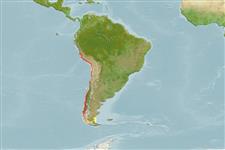Common names from other countries
Environment: milieu / climate zone / depth range / distribution range
Ecologie
; diepteverspreiding 10 - 1138 m (Ref. 87391). Temperate; 11°S - 54°S, 78°W - 68°W
Southeast Pacific and Southwest Atlantic: Chile and Peru.
Length at first maturity / Size / Gewicht / Leeftijd
Maturity: Lm ? range ? - ? cm Max length : 15.0 cm CW mannelijk/geslacht niet bekend; (Ref. 78814); 11 cm CW (female)
Found on soft-bottom sublittoral habitats. Mainly epifaunal but can be considered a bioturbator as it reworks sediments. Notably disturbs the sea floor, exhibiting "sediment mining" behavior while in search of prey. Predatory (Ref. 106462).
Life cycle and mating behavior
Geslachtsrijpheid | Voortplanting | Kuitschieten | Eieren | Fecundity | Larven
Members of the order Decapoda are mostly gonochoric. Mating behavior: Precopulatory courtship ritual is common (through olfactory and tactile cues); usually indirect sperm transfer.
Gorny, M. 1999. (Ref. 87391)
Status op de Rode Lijst van het IUCN (Ref. 130435)
Status bij CITES (Ref. 108899)
Not Evaluated
Not Evaluated
Gevaarlijk voor mensen
Harmless
Gebruik door de mens
Visserij: commercieel
FAO - Visserij: landings | FishSource | Sea Around Us
Tools
Meer informatie
Leeftijd/GrootteGroeiLengte-gewicht parametersLengte-lengte parametersMorfologieLarvenAbundantie
Internet-bronnen
Estimates based on models
Preferred temperature
(Ref.
115969): 6.5 - 12.3, mean 9.4 (based on 36 cells).
